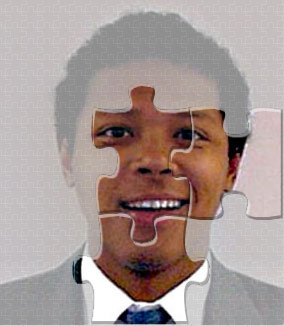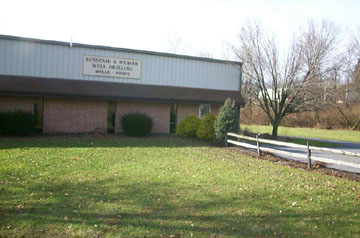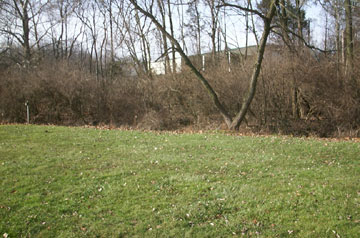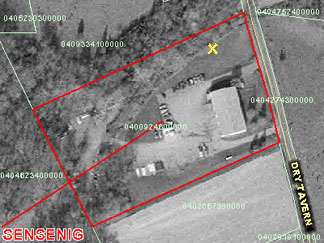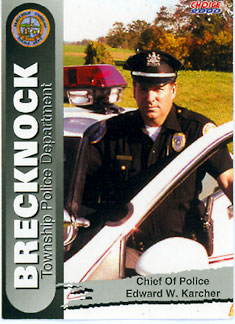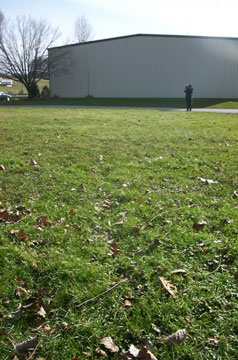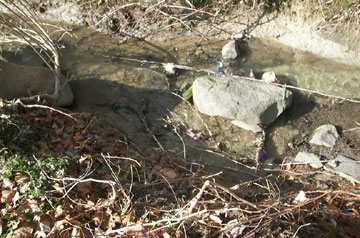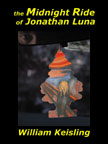The wind cries Jonathan
The local chief of police poses this question:
Had someone, weeks after the murder, returned to the scene of the crime and placed the knife in the stream?
by Bill Keisling
Almost a year after Jonathan Luna's death I drove out to the spot where Luna's body was found, in Denver, Pennsylvania, in rural Lancaster County. It was December 1, 2004. A storm had just blown through, and gusts of high wind whipped all around.
The spot where Jonathan died is about two miles from the turnpike exit, as the crow flies. It's a surprisingly hard place to find, due to twisty country roads. One can't ignore the isolation of the spot. One would seem to have to know one's way around to quickly find the place, and make good a getaway.
"Jonathan Luna died in a lonely, ugly place," the Washington Post wrote shortly after Jonathan's death in 2003, "a long, shallow creek that winter has turned brown and bare."
The Post got that wrong, I thought immediately, taking in the landscape. It's a pretty place, to my Pennsylvania eye. Rounded hills, fertile farmland, and cheerful homes paint the terrain.
Sensenig and Weaver building (top), with driveway on right; you can just see, at far right, (and bottom photo) the y-shaped tree where Luna's body was found
I parked in the parking lot of Sensenig and Weaver Well Drilling, on Dry Tavern Road. It's a modern building with a line of employee cars parked in a side lot, and well-drilling rigs poking the sky out back. I tried the front door, but found it locked. A woman worked in the office inside. I caught her attention, and with a smile she unlocked the door and let me in.
"I know you're probably tired of being asked," I began, "but I'm writing about Jonathan Luna and wonder if you might show me where--."
She understands what I'm asking. She leads me outside and points across the driveway, to a Y-shaped tree, by a small stream, to an unmarked spot maybe a hundred feet or so from the side of the building. It's surprisingly close to both the road and the building, I see. Maybe a hundred feet or so from the road.
The Sensenig and Weaver folks turn out to be nice people. They're a little scared, and a little dumbfounded. They think Luna was murdered, and they're fearful whoever did it might come back. The woman asked me not to print her name. "I don't want them coming back for me," she says.
Their lives, and business, have not been the same since the prosecutor was found dead in their stream. Since that strange morning little has been usual. Early on, teams of FBI agents and state police overran the crime scene. Dan Gehman, who first spotted the idling car at the stream, found himself inundated by calls from the press and national television shows.
Yellow x marks approximate spot where Luna's body was found
Everything about Luna's death seems extraordinary, and as twisted as the back roads of Denver, PA. And little seems to make sense. The well-drilling building is flanked on both sides by driveways, though the most-oft-used driveway is to the right of the building, where Luna's car was found. Daniel Gehman had come to work that morning around five, and spent some time inside the building "making coffee and stuff like that," I was told, before he went outside and noticed the red light on the car's dashboard by the dark stream at 5:30 am. When Gehman arrived at work he had not noticed the car by the stream. Gehman is a big, friendly man with long hair, tied in a pony tail, and a moustache. Perhaps the car was already at the stream when he got to work, he tells me, and he just hadn't seen it. That's possible, he explains, because a floodlight at the side of the building was not working, and he had entered the nearby driveway from a direction that shone his headlights away from the stream.
While I spoke with Gehman, other Sensenig and Weaver workers gathered around to talk.
I explained that I had taken a year to examine the Baltimore end of the story. My fellow Pennsylvanians were eager to hear more. The residents of Lancaster County knew little of the scandalous Smith-Poindexter case on which Luna was working the night he died. Nor did they know about Baltimore U.S. Attorney Tom DiBiagio's deepening political and professional difficulties. They never even heard of the Dawsons. Let alone Alvin Jones. Where to begin? Events in Baltimore, I explained, were as scandalous as events here.
One hundred and fifty state police cadets had conducted a classic, shoulder-to-shoulder grid search, covering every square foot of the crime scene. The 150 cadets hadn't found the knife. Then, lo, weeks later, the knife turns up in the stream, in the same spot where Luna was found. Weeks of high water in the creek hadn't even washed the knife downstream a foot or two.
The night he died, Luna was trying to protect the FBI and was doing badly, I explained. The case Luna was working on was a very bad case for the Justice Department and the FBI and had to be ditched quickly, just as Luna's car had to be ditched that night.
"We really don't know much," the woman tells me, "only what you people come and tell us." The news had been sparse in the last few months, she explained. Except for one interesting development.
"Did you hear what happened?" the woman asked excitedly. "About two weeks ago, FBI agents drove up to see the county coroner. The FBI wanted the coroner to change the cause of Luna's death from murder to suicide. The coroner said he wouldn't do it. Someone got upset and quit."
In the intervening year since Luna's death, Lancaster County Coroner Dr. Barry Walp had retired from office. He was replaced as coroner by Lancaster physician Dr. Gary Kirchner. Walp's ruling of homicide had become a growing problem for the problem-plagued Baltimore FBI field office. As the anniversary of Luna's death neared, someone decided to approach the new Lancaster County coroner to have him change Luna's cause of death to suicide, to better sweep the case under the rug. The new coroner, Dr. Kirchner, looking at the facts of the case, refused. He wasn't buying the suicide whitewash, and neither were the people of Lancaster County, I saw. The official cause of death remains homicide.
The not-too-subtle ploy backfired on the FBI. The locals now were abuzz about what they characterized as the FBI's strange and heavy-handed treatment of their coroner. Why is the FBI trying to cover-up what obviously is a grisly murder? people were wondering. I could detect in the locals a growing suspicion. And I detected something else: an admiration and appreciation for their coroner. Grit, independence, and backbone remain important commodities in Lancaster County, Pennsylvania. As is the truth.
Every biographer, it's said, has a houseguest. I ended up carrying a sympathy for Luna, his family and his friends. Sometimes, working late at night, trying to get into Luna's mind, I could almost see Jonathan standing in front of me as I typed, as if trying to tell me something—. A writer's affectation, to be sure. But that day, visiting the murder scene, as I stood in the office of Sensenig and Weaver Well Drilling, a few feet away from where Jonathan Luna met his end, something odd happened.
Behind me, the door leading outside opened, then closed. I turned, but saw no one. "Oh it's the wind," the woman told me. It was a windy day. That's why, she said, she'd been locking the door. Behind me, as we spoke, gusts of wind kept blowing open the door, as if beckoning me outside. I kept turning to see who was coming in but saw no one. I didn't think much of it at the time.
A bearded employee, wearing overalls and an incredulous grin, appeared suddenly in the well-drilling office.
"The cops are outside taking pictures again!" he announced. "It just doesn't stop!" Their eyes rolled. The wind kept pulling open the door.
I excused myself and went outside. As chance would have it, the local police chief, Edward Karcher of the Brecknock Township Police Department, was being interviewed at the murder scene by a newspaper reporter and a photographer. The reporter turned out to be Brett Lovelace, police reporter for the Lancaster Intelligencer Journal, the daily newspaper in town. Lovelace was interviewing Chief Karcher for a story marking the first anniversary of Luna's death.
I introduced myself. We spoke briefly of the isolation of the spot, and the difficulty of finding the place due to the twisty, intersecting country roads. I asked Chief Karcher and Lovelace whether they realized Luna had been stabbed once for every thousand dollars missing from the Baltimore evidence vault. Neither immediately replied.
The photographer, in the brusque way of a camera operator, asked me to stand out of the way until he was done taking pictures. "I don't want any shadows," he barked. Chief Karcher stood by the creekside pointing down at the spot where Jonathan had been found.
It was really more of a stream than a creek, I saw. A stream maybe three or four feet wide, flowing at the bottom of a ditch maybe six feet deep, by ten feet wide. The creek bed ran down from the back of the property to Dry Tavern Road. "The creek was higher that morning," Chief Karcher said. He pointed out a slight embankment at the side of the creek, where the wheels of Luna's car had come to a stop. The other side of the creek was covered by brush and a thin woods. Farther beyond, up on a hill beyond the creek, a massive commercial building, such as a warehouse, was under construction. Nothing but steel beams and foundation. Who had known of this place, and how to get away from here so quickly? I ponder. Who hauls the trash?
"What's that up there?" Lovelace, or his photographer (I didn't catch which), casually asked, pointing at the new construction.
"I don't know what that is," Chief Karcher says, squinting at the construction on the hill. "I don't think that was here this time last year." The photographer meanwhile positioned himself on the far side of the creek to take more pictures. I took advantage of the loll to speak with Chief Karcher.
Chief Karcher's trading card (top). A year after Luna's death, you could still see the tire tracks on the lawn (bottom).
Chief Karcher struck me as professional, earnest and concerned. The sort of chief every community should have. He handed me one of those baseball-style trading cards with his picture on the front. On the card he stands opening the driver's door to his black and white. "They're really for the kids to collect," he tells me.
"These cards are neat," I say. York Police Commissioner Herbert Grofcsik also gave me one. The good cops all seem to have a trading card.
The back of Karcher's card reports that Chief Karcher has worked as a police officer since 1979. He enjoys spending time with his family, and he's a Civil War buff. A personal message from the chief reads, "We must support and educate our children, because they are our future. The care of our families should be our number one goal in life." The same things coincidentally that Jonathan Luna cared about. That I care about.
Chief Karcher explained he had patrolled the area that night about 2 am, before he'd gone off his shift, and had seen nothing unusual. You could still see the tire tracks from Jonathan's car in the grass, he said. He pointed down into the grass. Sure enough, a year later, I saw the faint outlines of tire tracks. I felt a connection with Luna, even a slight tingle.
The tire tracks from Luna's car actually began behind the building, and led some distance to the stream. "They were behind the building, doing something," Ron Weaver, one of the principals of the firm, told me. This leads the locals to believe that Luna may have been left for dead behind the building. After his assailants departed the scene, Luna may have gotten behind the wheel to escape, only makiing it as far as the driveway before veering off into the stream. Luna's car was found idling, in neutral, with the hand brake set. The front wheels were hung up on the embankment siding the creek, the car overhanging the water. Luna's body actually was balled up under the front of the car, almost in a fetal position. A large streak of blood ran down the driver's door, as though smeared by a hand when Luna got out of the car.
As I stood by the creek taking all this in, a remarkable conversation ensued with the local chief of police. Chief Karcher said his department had not been notified by the state police the morning of Luna's death. The state police responded to the after-hours call, an arrangement common in many rural Pennsylvania communities. One of Karcher's men had heard about the murder, and the ongoing state police investigation, from a third party. Chief Karcher said one would think the state police would at least have had the "common courtesy" to advise him of events.
"Is that unusual that you weren't informed?" I asked.
He said it "never happened before. Not in the—" (he counted) "seven years I've been chief of police here."
I asked about complaints I'd just heard that the FBI had tried to "strongarm" the county coroner into changing the cause of death to suicide.
"Well, they didn't 'strongarm' the coroner," Chief Karcher corrected me. "The FBI asked him to change it. The coroner, he just wasn't going to do it." Reporter Lovelace nodded his head in agreement.
"What do you think about the suicide theory, Chief?" I asked.
Let me put it like this, the chief draws back. In all his years of police work, Chief Karcher offers, he's never known a man to die by stabbing himself thirty-six times, including once through the throat.
Both Chief Karcher and reporter Lovelace had to repress a snicker. No one in Lancaster County was buying the suicide story. We spoke briefly about the affidavit written out by state trooper Douglas Burig the morning of the death, in order to search Luna's car. It's on file at local magistrate Rodney Hartman's office, in nearby New Holland, Chief Karcher said. In the affidavit, Trooper Burig notes a pool of blood on the right rear floor of the car. To have killed himself, Luna would not only had to have stabbed himself as he drove down the turnpike, thus leaving a spot of blood on the turnpike ticket. Bleeding, he then would had to have gotten into the backseat, thrown around his own money and personal effects, crawled to the floor, bled profusely, before returning to the driver's seat (where Trooper Burig noted no blood), before somehow driving to the creek at Sensenig and Weaver Well Drilling, where he then crawled from the car. It's not only impossible, it's both amazing and insulting that the FBI thinks the public is gullible enough to believe this.
Chief Karcher sketched what he estimated was a more likely scenario. It was a homicide, Chief Karcher said, looking out over the small stream. "They used this place as a dumping ground. They dumped the car, and left him for dead," the chief said. After his assailant or assailants had run off, Luna revived enough to stumble from the car, smearing blood on the door and fender as he groped in the dark, disoriented and in shock, into the creek, where he drowned.
For a moment I stood silently considering the assailant running from the ditched car, running from the vanishing night. "Justice had with valour arm'd / Compell'd these skipping kerns to trust their heels," Shakespeare writes.
Again I mentioned to Chief Karcher that Luna had been stabbed once for every thousand dollars missing from the courthouse evidence vault. This time Chief Karcher starts and says, "I hadn't realized that before."
"A criminologist would call it a 'crime signature,'" I said.
This, and the oddly unprofessional and suspicious FBI behavior, seemed to jog dark suspicions in Chief Karcher's mind. He said there was something funny about the way Luna's knife had been found in the stream. "The knife wasn't found right away, you know," the chief offered.
"It was found almost two months later, in January," I said.
The stream where Luna's body was found. Weeks later, after shoulder-to-shoulder grid searches involving hundreds of police officers and cadets, Luna's knife was found near the same rock.
"That's right," Chief Karcher agreed. "Here's where they found the knife—." The chief walked to the embankment and pointed down into the stream, to the spot where Luna's body had been found. The stream ran around a small rock. "They found it right there, by the rock. Where the body was."
What was odd about that, the chief commented, was that the area had previously been thoroughly scoured by FBI agents and the Pennsylvania state police. Did I realize, the chief asked, that the state police brought in 150 cadets to search the entire area after the murder? The 150 cadets, he said, had conducted a classic, shoulder-to-shoulder grid search, covering every square foot of the scene from the Sensenig and Weaver driveway to the stream, and beyond. "They even searched the road down to the next intersection, I believe," the chief adds.
The 150 cadets hadn't found the knife. Then, lo, weeks later, the knife turns up in the stream, in the same spot where Luna was found. Weeks of high water in the creek hadn't even washed the knife downstream a foot or two.
Chief Karcher cast his level gaze at reporter Brett Lovelace and me to wordlessly ask, What do you think of that? The chief didn't have to say what we all thought.
Someone, weeks after Jonathan's death, had returned to the murder scene and placed the knife in the stream.
